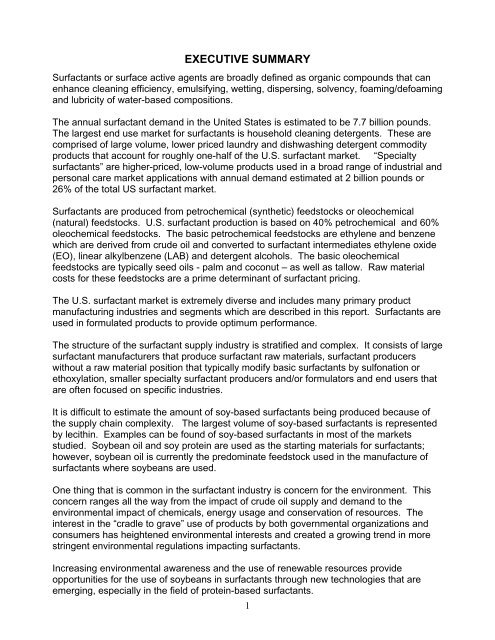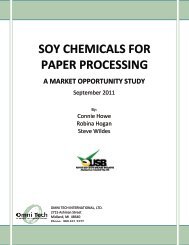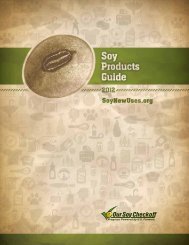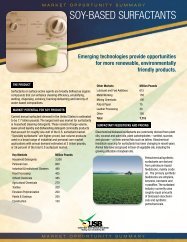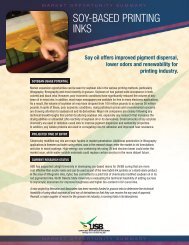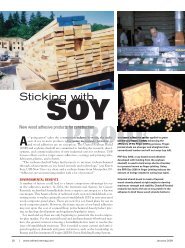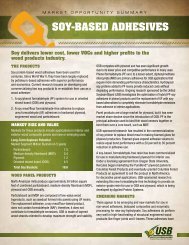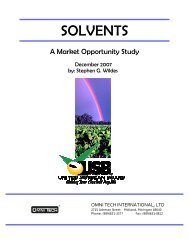Surfactants Market Opportunity Study - January 2009 - Soy New Uses
Surfactants Market Opportunity Study - January 2009 - Soy New Uses
Surfactants Market Opportunity Study - January 2009 - Soy New Uses
You also want an ePaper? Increase the reach of your titles
YUMPU automatically turns print PDFs into web optimized ePapers that Google loves.
EXECUTIVE SUMMARY<br />
<strong>Surfactants</strong> or surface active agents are broadly defined as organic compounds that can<br />
enhance cleaning efficiency, emulsifying, wetting, dispersing, solvency, foaming/defoaming<br />
and lubricity of water-based compositions.<br />
The annual surfactant demand in the United States is estimated to be 7.7 billion pounds.<br />
The largest end use market for surfactants is household cleaning detergents. These are<br />
comprised of large volume, lower priced laundry and dishwashing detergent commodity<br />
products that account for roughly one-half of the U.S. surfactant market. “Specialty<br />
surfactants” are higher-priced, low-volume products used in a broad range of industrial and<br />
personal care market applications with annual demand estimated at 2 billion pounds or<br />
26% of the total US surfactant market.<br />
<strong>Surfactants</strong> are produced from petrochemical (synthetic) feedstocks or oleochemical<br />
(natural) feedstocks. U.S. surfactant production is based on 40% petrochemical and 60%<br />
oleochemical feedstocks. The basic petrochemical feedstocks are ethylene and benzene<br />
which are derived from crude oil and converted to surfactant intermediates ethylene oxide<br />
(EO), linear alkylbenzene (LAB) and detergent alcohols. The basic oleochemical<br />
feedstocks are typically seed oils - palm and coconut – as well as tallow. Raw material<br />
costs for these feedstocks are a prime determinant of surfactant pricing.<br />
The U.S. surfactant market is extremely diverse and includes many primary product<br />
manufacturing industries and segments which are described in this report. <strong>Surfactants</strong> are<br />
used in formulated products to provide optimum performance.<br />
The structure of the surfactant supply industry is stratified and complex. It consists of large<br />
surfactant manufacturers that produce surfactant raw materials, surfactant producers<br />
without a raw material position that typically modify basic surfactants by sulfonation or<br />
ethoxylation, smaller specialty surfactant producers and/or formulators and end users that<br />
are often focused on specific industries.<br />
It is difficult to estimate the amount of soy-based surfactants being produced because of<br />
the supply chain complexity. The largest volume of soy-based surfactants is represented<br />
by lecithin. Examples can be found of soy-based surfactants in most of the markets<br />
studied. <strong>Soy</strong>bean oil and soy protein are used as the starting materials for surfactants;<br />
however, soybean oil is currently the predominate feedstock used in the manufacture of<br />
surfactants where soybeans are used.<br />
One thing that is common in the surfactant industry is concern for the environment. This<br />
concern ranges all the way from the impact of crude oil supply and demand to the<br />
environmental impact of chemicals, energy usage and conservation of resources. The<br />
interest in the “cradle to grave” use of products by both governmental organizations and<br />
consumers has heightened environmental interests and created a growing trend in more<br />
stringent environmental regulations impacting surfactants.<br />
Increasing environmental awareness and the use of renewable resources provide<br />
opportunities for the use of soybeans in surfactants through new technologies that are<br />
emerging, especially in the field of protein-based surfactants.<br />
1


